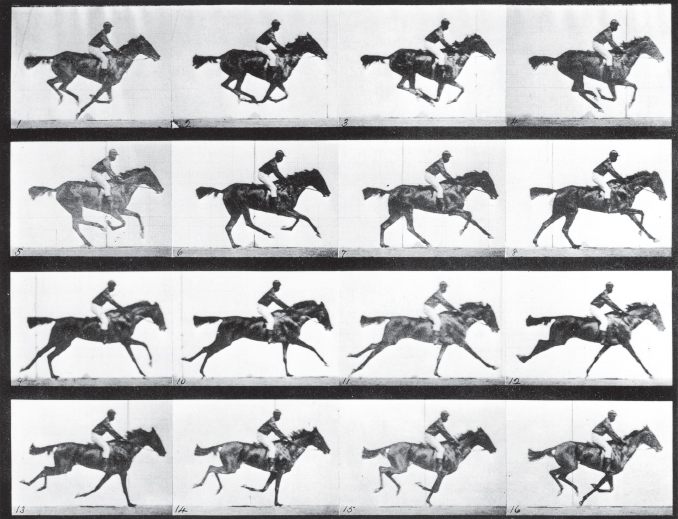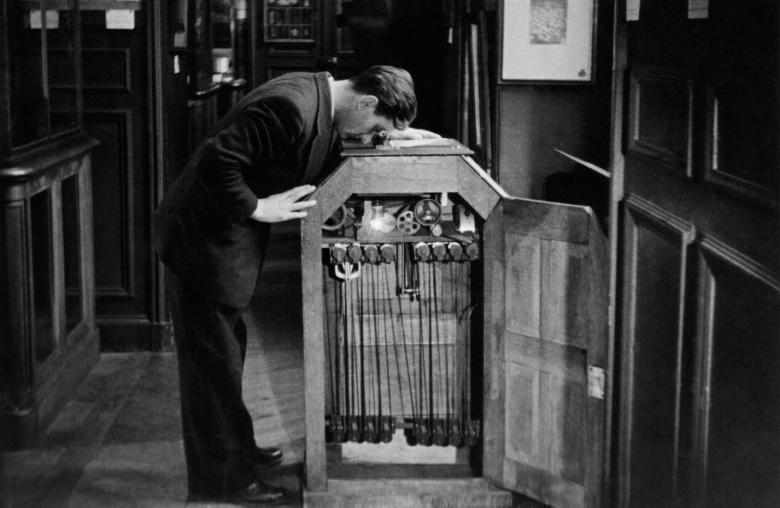The Development of Film
The concept of film goes back as early as Leonardo da Vinci, who theorized in the late 1400s about creating a device that would reproduce reality. Other early precursors to film included the Magic Lantern in the seventeenth century, which projected images painted on glass plates using an oil lamp as a light source; the invention of the thaumatrope in 1824, a two-sided card with different images on each side that appeared to combine the images when twirled; and finally, the introduction in 1834 of the zoetrope, a cylindrical device that rapidly twirled images inside a cylinder, which appeared to make the images move.
Muybridge and Goodwin Make Pictures Move
The development stage of movies began when inventors started manipulating photographs to make them appear to move while simultaneously projecting them on a screen. Eadweard Muybridge, an English photographer living in America, is credited with being the first to do both. He studied motion by using multiple cameras to take successive photographs of humans and animals in motion. One of Muybridge’s first projects involved using photography to determine if a racehorse actually lifts all four feet from the ground at full gallop (it does). By 1880, Muybridge had developed a method for projecting the photographic images on a wall for public viewing. These early image sequences were extremely brief, showing only a horse jumping over a fence or a man running a few feet, because only so many photographs could be mounted inside the spinning cylinder that projected the images.
Movies and the Impact of Images


Meanwhile, other inventors were also working on capturing moving images and projecting them. In 1884, George Eastman (founder of Eastman Kodak) developed the first roll film—a huge improvement over the heavy metal and glass plates used to make individual photos. The first roll film had a paper backing that had to be stripped off during the film developing stage. Louis Aimé Augustin Le Prince, a Frenchman living in England, invented the first motion picture camera using roll film. Le Prince, who disappeared mysteriously on a train ride to Paris in 1890, is credited with filming the first motion picture, Roundhay Garden Scene, in 1888. About two seconds’ worth of the film survives today.
In 1889, a New Jersey minister, Hannibal Goodwin, improved Eastman’s roll film by using thin strips of transparent, pliable material called celluloid that could hold a coating of chemicals sensitive to light. Goodwin’s breakthrough solved a major problem: It enabled a strip of film to move through a camera and be photographed in rapid succession, producing a series of pictures. Because celluloid was transparent (except for the images made on it during filming), it was ideal for projection, as light could easily shine through it. George Eastman, who also announced the development of celluloid film, legally battled Goodwin for years over the patent rights. The courts eventually awarded Goodwin the invention, but Eastman’s company still became the major manufacturer of film stock for motion pictures by buying Goodwin’s patents.
Edison and the Lumières Create Motion Pictures
As with the development of sound recording, Thomas Edison takes center stage in most accounts of the invention of motion pictures. In the late 1800s, Edison initially planned to merge phonograph technology and moving images to create talking pictures (which would not happen in feature films until 1927). Because there was no breakthrough, however, Edison lost interest. He directed an assistant, William Kennedy Dickson, to combine Edison’s incandescent lightbulb, Goodwin’s celluloid, and Le Prince’s camera to create another early movie camera, the kinetograph, and a single-person viewing system, the kinetoscope. This small projection system housed fifty feet of film that revolved on spools (similar to a library microfilm reader). Viewers looked through a hole and saw images moving on a tiny plate. In 1894, the first kinetoscope parlor, featuring two rows of coin-operated machines, opened on Broadway in New York.

Meanwhile, in France, brothers Louis and Auguste Lumière developed the cinematograph, a combined camera, film development, and projection system. The projection system was particularly important, as it allowed more than one person at a time to see the moving images on a large screen. In a Paris café on December 28, 1895, the Lumières projected ten short movies for viewers who paid one franc each, on such subjects as a man falling off a horse and a child trying to grab a fish from a bowl. Within three weeks, twenty-five hundred people were coming each night to see how, according to one Paris paper, film “perpetuates the image of movement.”
With innovators around the world now dabbling in moving pictures, Edison’s lab renewed its interest in film. Edison patented several inventions and manufactured a new large-screen system called the vitascope, which enabled filmstrips of longer lengths to be projected without interruption and hinted at the potential of movies as a future mass medium. Staged at a music hall in New York in April 1896, Edison’s first public showing of the vitascope featured shots from a boxing match and waves rolling onto a beach. The New York Times described the exhibition as “wonderfully real and singularly exhilarating.” Some members of the audience were so taken with the realism of the film images that they stepped back from the screen’s crashing waves to avoid getting their feet wet.
Early movie demonstrations such as these marked the beginning of the film industry’s entrepreneurial stage. At this point, movies consisted of movement recorded by a single continuous camera shot. Early filmmakers had not yet figured out how to move the camera around or how to edit film shots together. Nonetheless, various innovators were beginning to see the commercial possibilities of film. By 1900, short movies had become a part of the entertainment industry, being utilized in amusement arcades, traveling carnivals, wax museums, and vaudeville theater.